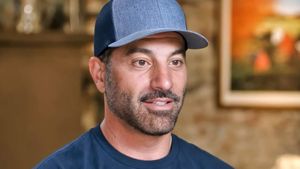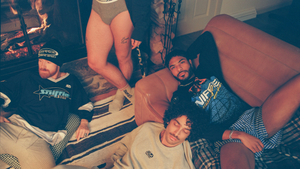We all have a
breaking point. One American Airlines purser found hers on
August 22 on Flight 45 from Paris to New York City. I
imagine it was like Snakes on a Plane. Only it
wasn't snakes; it was gays. I envision her
paraphrasing Samuel L. Jackson's character:
"Enough is enough. I have had it with these
motherfucking gays on this motherfucking plane."
The gays in
question were a couple--TV journalist George
Tsikhiseli and writer Stephan Varnier. They had been
together for only four months, so they were still in a
doting mood. Shortly after takeoff, Varnier nodded off
with his head on Tsikhiseli's shoulder. A flight
attendant came over and told them the purser wanted
them to "stop that." Varnier didn't
know what she was talking about. The flight attendant
specified that they should stop "the touching
and the kissing," and she walked away.
The couple hailed
the purser. To their surprise, she said she had made no
such demand. She asked them to point out the flight
attendant, whom a passenger seated behind them
described to the purser as having "Texas hair,
like from the 1960s." According to David Leisner, a
man seated behind the couple, the purser rolled her
eyes and said, "Oh, say no more. I
know." After listening to a description of what they
had been doing, she agreed that their behavior had not
been out of order.
Tsikhiseli then
asked if the flight attendant would have hassled them if
they had been a straight couple. The purser, they say,
"became very rigid" and opined that
"kissing is inappropriate behavior on an
airplane." She left them to take care of other
passengers. When she returned half an hour later, she
said other passengers had been complaining about their
behavior. [For a statement from American Airlines, see
page 45.] Though pressed by the gay couple, the purser
refused to identify the passengers, name the flight
attendant, or arrange for an American Airlines
representative to meet them when they landed. She then
said that if they did not settle down, the flight would be
diverted. Half an hour later, the captain reaffirmed to
Tsikhiseli that he would indeed divert the plane if
they did not drop the matter.
When asked to
comment, an American Airlines representative defended all
three employees: "Our passengers need to recognize
that they are in an environment with all ages,
backgrounds, creeds, and races. We have an obligation
to make as many of them feel as comfortable as
possible." He also elaborated that the
airline's "understanding is that the level of
affection was more than a quick peck on the cheek."
But as Leisner clarified in an update posted on the
Internet: "You can assure anyone that questions
the degree of affection these guys were showing that it
was very innocent--hand-holding, resting one's
head on the other's shoulder, and repeated
kissing (but not French kissing)."
I first
encountered this story in The New Yorker's
Talk of the Town, a section to which I repeatedly turn
for consolation after confirming that I have once
again failed to win the Cartoon Caption Contest. I
found the story oddly riveting. A spin through the
blogosphere showed I was not alone. Why was the
incident so compelling to so many? I came up with
three answers.
First, the gays
on the plane expected equal treatment. When Varnier was
woken from his happy slumber on his boyfriend's
shoulder and told to "stop that," he
didn't know what "that" meant. Before
that rude awakening, he didn't think of his
"kissing" and "touching" as
extraordinary. It was less like a gay kiss-in than a 1980s
straight honeymoon.
The right to
canoodle is not in the Constitution. The couple's
assumption that they had that right, however, marks a
milestone in gay rights. When I teach gay history to
my students I tell it as a history of weakening
demands for conformity to straight norms--the demand
to convert, the demand to pass, and the demand to
cover. Through the middle decades of the 20th century
gays were routinely pressured to convert to
heterosexuality, whether through psychoanalysis,
electroshock therapy, lobotomies, or even castration.
After the rise of the gay rights movement the demand
to convert shifted in emphasis toward the demand to
pass--we were told that we would not be
witch-hunted out of our closets so long as we spent
our entire lives in them. And at the turn of the millennium
the demand to pass is shifting toward the
"demand to cover"--sociologist
Erving Goffman's phrase for how people experience
pressure to downplay known stigmatized traits, even
after we reveal them. Gays are increasingly told that
we can be openly gay so long as we don't
"flaunt" our sexual orientation by being
too "flamboyant," too
"militant," or, as in this case, too
"public" in our displays of affection for each
other.




































































Charlie Kirk DID say stoning gay people was the 'perfect law' — and these other heinous quotes